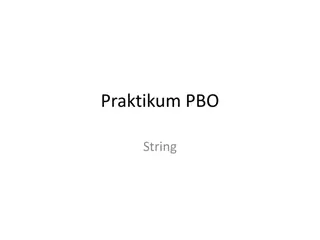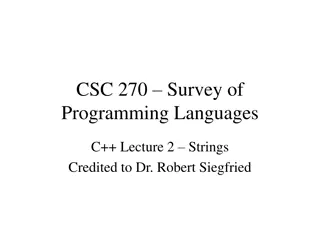Understanding Horspool's Algorithm in String Searching
Learn about Horspool's Algorithm, a simplified variation of Boyer-Moore algorithm for efficient string searching. Explore how it shifts patterns intelligently to optimize matching, avoiding unnecessary comparisons. Discover the key concept of character mismatch handling and efficient pattern shifting strategies.
Download Presentation

Please find below an Image/Link to download the presentation.
The content on the website is provided AS IS for your information and personal use only. It may not be sold, licensed, or shared on other websites without obtaining consent from the author. Download presentation by click this link. If you encounter any issues during the download, it is possible that the publisher has removed the file from their server.
E N D
Presentation Transcript
MA/CSSE 473 Day 25 Student questions String search Horspool Boyer Moore intro
Brute Force, Horspool, Boyer-Moore STRING SEARCH
Brute Force String Search Example The problem: Search for the first occurrence of a pattern of length m in a text of length n. Usually, m is much smaller than n. What makes brute force so slow? When we find a mismatch, we can shift the pattern by only one character position in the text. Text: Pattern:abracadabra abracadabra abracadabra abracadabra abracadabra abracadabra abracadabtabradabracadabcadaxbrabbracadabraxxxxxxabracadabracadabra
Faster String Searching Was a HW problem Brute force: worst case m(n-m+1) A little better: but still (mn) on average Short-circuit the inner loop
What we want to do When we find a character mismatch Shift the pattern as far right as we can With no possibility of skipping over a match.
Horspool's Algorithm A simplified version of the Boyer-Moore algorithm A good bridge to understanding Boyer-Moore Published in 1980 Recall: What makes brute force so slow? When we find a mismatch, we can only shift the pattern to the right by one character position in the text. Text: abracadabtabradabracadabcadaxbrabbracadabraxxxxxxabracadabracadabra Pattern:abracadabra abracadabra abracadabra abracadabra Can we sometimes shift farther? Like Boyer-Moore, Horspool does the comparisons in a counter-intuitive order (moves right-to-left through the pattern)
Horspool's Main Question If there is a character mismatch, how far can we shift the pattern, with no possibility of missing a match within the text? What if the last character in the pattern is compared to a character in the text that does not occur anywhere in the pattern? Text: ... ABCDEFG ... Pattern: CSSE473
How Far to Shift? Look at first (rightmost) character in the part of the text that is compared to the pattern: The character is not in the pattern .....C.......... {C not in pattern) BAOBAB The character is in the pattern (but not the rightmost) .....O..........(O occurs once in pattern) BAOBAB .....A..........(A occurs twice in pattern) BAOBAB The rightmost characters do match .....B...................... BAOBAB
Shift Table Example Shift table is indexed by text and pattern alphabet E.g., for BAOBAB: A B C D E F G H I J K L M N O P Q R S T U V W X Y Z 1 2 6 6 6 6 6 6 6 6 6 6 6 6 3 6 6 6 6 6 6 6 6 6 6 6 EXERCISE: Create the shift table for COCACOLA (on your handout)
Example of Horspools Algorithm _ A B C D E F G H I J K L M N O P Q R S T U V W X Y Z 1 2 6 6 6 6 6 6 6 6 6 6 6 6 3 6 6 6 6 6 6 6 6 6 6 6 6 BARD LOVED BANANAS (this is the text) BAOBAB (this is the pattern) BAOBAB BAOBAB BAOBAB (unsuccessful search)
Horspool Example pattern = abracadabra text = abracadabtabradabracadabcadaxbrabbracadabraxxxxxxabracadabracadabra shiftTable: a3 b2 r1 a3 c6 a3 d4 a3 b2 r1 a3 x11 abracadabtabradabracadabcadaxbrabbracadabraxxxxxxabracadabracadabra abracadabra abracadabtabradabracadabcadaxbrabbracadabraxxxxxxabracadabracadabra abracadabra abracadabtabradabracadabcadaxbrabbracadabraxxxxxxabracadabracadabra abracadabra abracadabtabradabracadabcadaxbrabbracadabraxxxxxxabracadabracadabra abracadabra abracadabtabradabracadabcadaxbrabbracadabraxxxxxxabracadabracadabra abracadabra abracadabtabradabracadabcadaxbrabbracadabraxxxxxxabracadabracadabra abracadabra abracadabtabradabracadabcadaxbrabbracadabraxxxxxxabracadabracadabra abracadabra Continued on next slide
Horspool Example Continued pattern = abracadabra text = abracadabtabradabracadabcadaxbrabbracadabraxxxxxxabracadabracadabra shiftTable: a3 b2 r1 a3 c6 a3 d4 a3 b2 r1 a3 x11 abracadabtabradabracadabcadaxbrabbracadabraxxxxxxabracadabracadabra abracadabra abracadabtabradabracadabcadaxbrabbracadabraxxxxxxabracadabracadabra abracadabra abracadabtabradabracadabcadaxbrabbracadabraxxxxxxabracadabracadabra abracadabra abracadabtabradabracadabcadaxbrabbracadabraxxxxxxabracadabracadabra abracadabra abracadabtabradabracadabcadaxbrabbracadabraxxxxxxabracadabracadabra abracadabra abracadabtabradabracadabcadaxbrabbracadabraxxxxxxabracadabracadabra abracadabra 49 Using brute force, we would have to compare the pattern to 50 different positions in the text before we find it; with Horspool, only 13 positions are tried.
Boyer Moore Intro When determining how far to shift after a mismatch Horspool only uses the text character corresponding to the rightmost pattern character Can we do better? Often there is a partial match (on the right end of the pattern) before a mismatch occurs Boyer-Moore takes into account k, the number of matched characters before a mismatch occurs. If k=0, same shift as Horspool.
Boyer-Moore Algorithm Based on two main ideas: compare pattern characters to text characters from right to left precompute the shift amounts in two tables bad-symbol table indicates how much to shift based on the text s character that causes a mismatch good-suffix table indicates how much to shift based on matched part (suffix) of the pattern
Bad-symbol shift in Boyer-Moore If the rightmost character of the pattern does not match, Boyer-Moore algorithm acts much like Horspool If the rightmost character of the pattern does match, BM compares preceding characters right to left until either all pattern s characters match, or a mismatch on text s character c is encountered after k > 0 matches text pattern k matches bad-symbol shift: How much should we shift by? d1 = max{t1(c ) - k, 1} , where t1(c) is the value from the Horspool shift table.
Boyer-Moore Algorithm After successfully matching 0 < k < m characters, the algorithm shifts the pattern right by d = max {d1, d2} where d1 = max{t1(c) - k, 1} is the bad-symbol shift d2(k) is the good-suffix shift Remaining question: How to compute good-suffix shift table? d2[k] = ???
Boyer-Moore example (Levitin) _ A B C D E F G H I J K L M N O P Q R S T U V W X Y Z 1 2 6 6 6 6 6 6 6 6 6 6 6 6 3 6 6 6 6 6 6 6 6 6 6 6 6 B E S S _ K N E W _ A B O U T _ B A O B A B S B A O B A B d1 = t1(K) = 6 B A O B A B d1 = t1(_)-2 = 4 d2(2) = 5 B A O B A B d1= t1(_)-1 = 5 d2(1) = 2 3 BAOBAB 5 4 BAOBAB 5 5 BAOBAB 5 k d2 2 5 pattern 1 2 BAOBAB BAOBAB B A O B A B (success)























